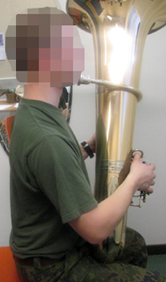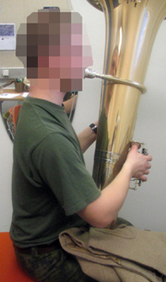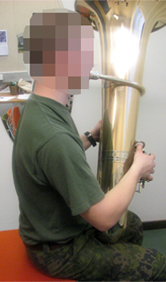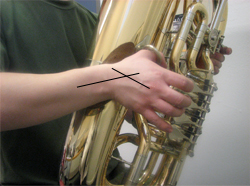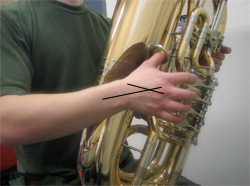Tuuba - harjoittelu
Tuuba
Kehon keskiasento on soittajan perusasento, johon hän aina palaa. Keskiasennossa selkärangan luonnolliset kaarirakenteet säilyvät. Selkärangan kaarien muodot ovat yksilölliset, joten kaikkien selkä ja lantio eivät näytä samalta keskiasennossa.
Lue Yleistä ergonomiasta ensin.
Hyvää soittoasentoa haettaessa tuubansoittajan tulee ensimmäiseksi tarkastella lantion asentoaan. Lantion tulee olla keskiasennossa, niin että lantiota ja selkärankaa tukevat lihakset pääsevät toimimaan (istuen istuinluut osoittavat suoraan alaspäin). Tuuba on painava soitin ja siksi soittaja tarvitsee vahvojen lapaluu seudun lihaksien lisäksi hyvää keskivartalon lihasten hallintaa.
Rintaranka tulee myös säilyttää keskiasennossa hyvän rintakehän liikkuvuuden ja hengityksen saavuttamiseksi. Rintarangan ollessa keskiasennossa rintalasta on pystyasennossa ja selän ojentajalihakset ovat aktiiviset, mutta eivät jännittyneet. Sisään hengityksen aikana rintakehä pääsee laajenemaan vapaasti joka suuntaan, myös sivulle ja taaksepäin. Rintakehän/rintarangan ja lantion tulee olla linjassa keskenään sivulta katsottuna. Rintarangan kallistuminen taaksepäin suhteessa lantioon huonontaa rintakehän ja pallean liikettä ja huonontaa siten myös hengitystä.
Pään ja niskan keskiasentoa etsitään viemällä päätä eteen ja taakse ja jättämällä pää keskiasentoon, jolloin kallon ja kaularangan välinen liike on vapaa. Niskan-, pään- ja leukanivelen asento vaikuttaa kaulalihasten, leukalihasten ja kurkun lihasten hallintaan. Niskan ja pään on oltava keskiasennossa jossa pään asentoa kannattelevat syvät niska- ja kaulalihakset pääsevät toimimaan. Kyseiset lihakset ovat ns. tukilihaksia, jotka tekevät pinnallisten lihasten rentouttamisen mahdolliseksi. Pään työntyminen eteenpäin (johtuu usein alemmasta rangan virheasennosta) lisää jännitystä niskalihaksissa, leukalihaksissa ja kaulan pinnallisissa lihaksissa, joka voi haitata soittotekniikkaa.
Hyvä rintarangan ja rintakehän asento antaa hyvät toimintaedellytykset lapaluiden tukilihaksille. Lapaluiden tulee olla pystyasennossa kylkiluita vasten, jolloin hartiat ovat luonnollisessa asennossa. Lapaluun kallistuessa eteenpäin ja/tai siivetessä irti kylkiluista, lapaluun tukilihakset toimivat huonosti ja huonontavat myös rintakehän liikkuvuutta. Lapaluun kolmiulotteista liikettä on vaikea hahmottaa, joten lapaluun asentoharjoituksissa soittaja voi tarvita ammattiapua.
Niskan ja pään ollessa keskiasennossa huulet osuvat tuuban suukappaleeseen ilman, että päätä tarvitsee työntää eteenpäin tai vartaloa laskea alaspäin. Soittimen ja reiden väliin laitetaan sopivan kokoinen tyyny, jos soitin jää muuten liian alas. Soittimen ja suukappaleen ollessa liian alhaalla soittaja joutuu pyöristämään selkäänsä, joka kuormittaa alaselkää ja niska-hartiaseutua sekä huonontaa hengitystä.
|
Lantio ja selkäranka keskiasennossa, suukappale jää liian alas. |
Soittimen alle tyyny tms nostamaan soitinta oikealle korkeudelle. |
Lantio kallistuu taaksepäin ja selkäranka pyöristyy, soitin/suukappale liian alhaalla. |
Vasen käsivarsi ja erityisesti vasemman lapaluuseudun lihakset tukevat soitinta vartaloa vasten, huono lapaluun tuki johtaa helposti vartalon kiertymiseen. Oikeassa kädessä soitin vaatii laajaa ulottuvuutta Käden ulottuvuutta lisää hyvä toiminta kämmenen lihaksissa. Ranne tulisi pitää keskiasennossa, niin että ranne on 15 astetta ojennettuna ja 15 astetta kääntyneenä pikkusormeen päin. Tuubansoittajan tyypillinen ranteen virheasento on ranteen koukistus ja kallistus liikaa pikkusormeen päin, joka rasittaa rannetta.
|
Ranne kääntynyt liika pikkusormen puolelle. |
Ranne keskiasennossa, peukalon tukea tulisi siirtää alaspäin. |
Pään ja niskan työntäminen eteenpäin on suhteellisen yleistä vaskisoittimissa. Asentoon vaikuttaa osittain lantion ja lannerangan asento. Lantion ollessa eteenpäin kallistuneena pää työntyy eteenpäin, lisäksi pään eteenpäin tuominen voi olla myös puhdas tapa. Ajatus siitä, että tuo soittimen kohti huulia, (toisin kuin että vie huulet kohti soitinta) auttaa pitämään niskan ja pään keskiasennossa. Peiliä kannattaa käyttää apuna virheliikemalleista pois opittaessa.

